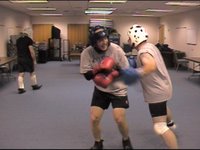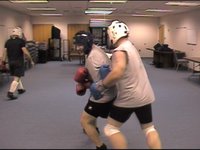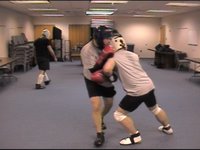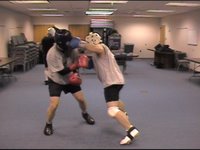1.
 1. Here is the step-around. Notice the check with my right hand. If I check above the elbow, I can turn the opponent, or step-around safely, and get away from this hands. I can also push to stop anything he can do with his feet or knees.
1. Here is the step-around. Notice the check with my right hand. If I check above the elbow, I can turn the opponent, or step-around safely, and get away from this hands. I can also push to stop anything he can do with his feet or knees.2.
 2. To prevent me from firing a counter, Sam bumps back into me to disrupt my counter.
2. To prevent me from firing a counter, Sam bumps back into me to disrupt my counter.3.
 3. Sam tries to turn around, escaping the check, and wants to counter. By bumping him with the shoulder, it traps his hands and gets him back on his heels. If you can't transfer your weight into something, you can't hurt it. Sam is now back on his heels, and I'm set.
3. Sam tries to turn around, escaping the check, and wants to counter. By bumping him with the shoulder, it traps his hands and gets him back on his heels. If you can't transfer your weight into something, you can't hurt it. Sam is now back on his heels, and I'm set.4.
 4. A short, straight left counter. You notice I am clearing around to the right again? Here we go!
4. A short, straight left counter. You notice I am clearing around to the right again? Here we go!

2 comments:
Nathan - Tell me more about the "check to the right". I've never heard of it. Is it like a right hand inward block that catches both his arms? Just a shove on the shoulder/bicep?
Thanks for the comment! A check is putting part of your body, usually a hand/arm for the upper body, or the foot for the lower body, in order to prevent it's use. For example, one could parry a punch, "stick" to the punch with the parrying hand as it returns, then apply some pressure to it to prevent it being used again. You could also check (obstruct) any kicks by placing your lead leg in front of your opponent's and applying pressure with your hip or calf. Please see this post on checking: http://tdatraining.blogspot.com/2006/01/checking.html
Post a Comment